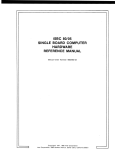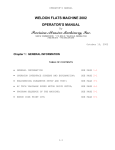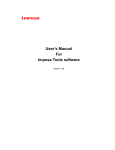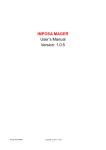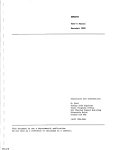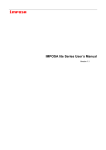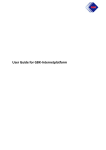Download Postal Code Counts User's Guide
Transcript
Postal Code Counts User’s Guide Population and Dwelling Counts Data in many forms Statistics Canada disseminates data in a variety of forms. In addition to publications, both standard and special tabulations are offered. Data are available on the Internet, compact disc, diskette, computer printouts, microfiche and microfilm, and magnetic tape. Maps and other geographic materials are available for some types of data. How to reach us For any questions about the data or software, please call our toll free Statistics Canada Electronic Products Help Line at 1 800 949-9491 or by Fax at 1 613 951-5520. For information about other products or services, call: National inquiries line 1 800 263-1136 National telecommunications device for the hearing impaired 1 800 363-7629 Order-only line (Canada and United States) 1 800 267-6677 You can also visit our World Wide Web site: http://www.statcan.ca Standards of service to the public To maintain quality service to the public, Statistics Canada follows established standards covering statistical products and services, delivery of statistical information, cost-recovered services and services to respondents. To obtain a copy of these service standards, please contact your nearest Statistics Canada Regional Reference Centre. Statistics Canada Postal Code Counts User’s Guide Population and Dwelling Counts Published by authority of the Minister responsible for Statistics Canada ©Minister of Industry, 1997 All rights reserved. No part of this product may be reproduced, stored in a retrieval system or transmitted in any form or by any means, electronic, mechanical, photocopying, recording or otherwise without prior written permission from Licence Services, Marketing Division, Statistics Canada, Ottawa, Ontario, Canada K1A 0T6. April 1997 User’s Guide for Catalogue No. 92F0086XCB ISBN 0-6660-59281-9 Ottawa Note of appreciation Canada owes the success of its statistical system to a longstanding co-operation involving Statistics Canada, the citizens of Canada, its businesses, governments and other institutions. Accurate and timely statistical information could not be produced without their continued co-operation and goodwill. TABLE OF CONTENTS 1. About this Guide ..................................................................................................................1 2. Overview...............................................................................................................................2 2.1. Introduction ............................................................................................................................................................... 2 2.2. Purpose of the Product .............................................................................................................................................. 2 2.3. Reference Date .......................................................................................................................................................... 2 3. Getting Started.....................................................................................................................3 3.1. Search ........................................................................................................................................................................ 3 3.2. Load Query................................................................................................................................................................ 3 3.3. Import ........................................................................................................................................................................ 4 4. About this Product...............................................................................................................5 4.1. Content ...................................................................................................................................................................... 5 4.2. Limitations................................................................................................................................................................. 5 4.3. Applications............................................................................................................................................................... 5 5. Data Quality .........................................................................................................................7 5.1. Lineage ...................................................................................................................................................................... 7 5.1.1. Method of Derivation ............................................................................................................................................. 7 5.1.1.1. Data Capture...................................................................................................................................................... 7 5.1.1.2. Edit and Imputation.......................................................................................................................................... 7 5.1.1.3. Certification ....................................................................................................................................................... 8 6. Technical Specifications ....................................................................................................12 6.1. Installation of Postal Code Counts.......................................................................................................................... 12 6.2. Installation of Adobe™ Acrobat™ Reader v2.1..................................................................................................... 13 6.3. Re-installing Postal Code Counts ........................................................................................................................... 14 7. Glossary of Terms..............................................................................................................15 Appendix A. Hierarchy of National, Metropolitan and Postal Code Geographic Units, 1996 ............................ 17 References ..................................................................................................................................................................... 18 Limited Use Data Product Licence Agreement ......................................................................................................... 19 1 About this Guide 1. About this Guide This user’s guide provides an overview of the Postal Code Counts CD-ROM product, including the general methodology used to create it. The Overview section provides an overview of the data contents and the purpose of the product. The Getting Started section describes the main menu of Postal Code Counts and provides explanations on the various functions of the programme. The uses and limitations of the product are discussed in section 4, About This Product. Section 5, Data Quality, provides information to evaluate the suitability of the data for a particular use. Installation instructions are provided in section 6, Technical Specifications. The glossary provides definitions of geographic terms and concepts in summary form only. More details can be found in the 1996 Census Dictionary (Catalogue No. 92-351-XPE). This user’s guide is based on the best information available at the time of release. It does not constitute a warranty of the data in the event that users may observe characteristics that deviate from those stated in this guide. All efforts have been made to ensure that the verification of this product has been thoroughly done. However, there is no guaranty that the data are 100% accurate. For further information, see Section 5, Data Quality. Statistics Canada – Cat. No. 92F0086XCB Postal Code Counts - Population and Dwelling Counts 2 Overview 2. Overview 2.1. Introduction The Postal Code Counts CD-ROM is a new product for the 1996 Census. It provides 1996 Census population and dwelling counts for all six-character postal codes reported by census respondents on the census questionnaire. The population and dwelling counts are provided by individual postal code, by forward sortation area (FSA - the first three characters of the six character postal code), by province/territory and for Canada. The data are provided with Windows -based software that enables users to perform data manipulations, such as searching the data set for specific postal codes, importing groups of postal codes for which counts are required and exporting groups of postal codes. 2.2. Purpose of the Product Postal Code Counts contains 1996 Census population and dwelling counts and software which makes it a useful tool for anyone interested in accessing census data or in analyzing administrative data by postal code. Statistics Canada has established certain thresholds below which data, with the exception of population and dwelling counts, will not be released to prevent the disclosure of confidential information about any individual. Since most six-character postal codes have populations below these thresholds, Postal Code Counts makes it possible to group postal codes to optimize on these thresholds. 2.3. Reference Date The population and dwelling counts are generated from the 1996 Census of Population and Housing which was conducted on May 14, 1996. The postal codes represent those postal codes reported by census respondents and were validated against Canada Post Corporation (CPC) postal code lists for May, 1996. Statistics Canada - Cat. No. 92F0086XCB Postal Code Counts - Population and Dwelling Counts 3 Getting Started 3. Getting Started When you install Postal Code Counts (see section 6.1), by default a ‘Census - 96 - Recensement’ program group is created. The Postal Code Counts icon is located in this program group. Double-clicking on this icon will launch the Postal Code Counts program. The first screen to appear will be the Statistics Canada logo followed by a language selection. Choose the language of preference. A licence agreement screen appears next with a choice of accepting the conditions of the licence agreement or not. If you click on the Accept button, you will proceed to the Postal Code Counts Main Menu screen. If you click on the Do not Accept button, you will automatically exit from the system. The three main functions available, Search, Load Query, and Import, are described in the following sections. For detailed instructions on proceeding through each of these steps, there are two possible directions you can take. If you would like to get information on a particular topic, then go into the Help menu in the Menu Bar and select either Contents or Search for Help on... to display a list of available help topics. If you would like help on the screen that you are in, then click on the Help button in the Toolbar to display the help topic for that screen. 3.1. Search Clicking on the Search button opens up Step 1 of 4 of the Search function. In this window, you can search for population and dwelling counts by postal code. To perform your search at a geographic level other than postal codes, click on the arrow to the right of the Level box to access the pull-down list and select the desired level of geography. The List Panel adjusts to display data for the selected level. Now you can click on the Next button to move on to Step 2 of 4. Please note that this button is disabled when the level is set at postal codes as it is the lowest level of data. Having selected the geographic level you want to work at, you must then choose the lower geographic level at which the data will be viewed. This screen provides a list of all the available geographic units in a descending hierarchical order. Since the levels are arranged hierarchically, the available levels listed in the panel are lower than the one selected in Step 1. Thus, if Canada or province/territory was selected in Step 1, the lower levels available in this step would be forward sortation area and postal codes. Likewise, if forward sortation area was selected in Step 1, the only lower level available in this step would be postal codes. Step 3 of 4 provides an interface to select the particular fields you wish to view. It also allows you to select a sort order so you can view the units in any desired order. You may add a condition to select only units which meet a particular criterion, such as those of a certain code, or with a certain population or dwelling count. You may also link a list of forward sortation areas (FSAs) or postal codes that you have to the data available in Postal Code Counts. In the final step, Step 4 of 4, the data are displayed in a table that may be scrolled through, printed, exported, or have some calculation performed on it. You may also use the Save Query function to save all of the steps you took to arrive at this point. Later, you could then use the Load Query function to bring you back to this point. 3.2. Load Query This function allows you to recall a saved query that was created by completing a Search. Saved queries allow you to carry out searches that are similar to the original saved query, but permits you to change the fields, sort orders or conditions necessary for your new search. Statistics Canada – Cat. No. 92F0086XCB Postal Code Counts - Population and Dwelling Counts 4 Getting Started Clicking on the Load Query button on the Main Menu opens up a screen containing a list of the names and descriptions of all previously saved queries, regardless of whether you have exited and re-entered the system. Load a query by selecting the query name and description by clicking on the grey button to the left of the name box. This will open the Step 3 of 4 screen from the Search function and allow you to revise or re-enter field selections, the sort order and conditions. You may delete queries you no longer need by using the Delete button. Postal Code Counts allows you to reverse any deletions by using the Recall button. However, the recall function will only recall deletions that were made while you are in the Load Query screen. Once you leave this screen, all deletions become permanent. 3.3. Import This function allows you to import a file containing a list of postal codes or forward sortation areas so that they may be linked to Postal Code Counts data using the Link file... option in Step 3 of 4 of the Search function. If your file contains a list of postal codes, then you may choose to import at either the postal code or the forward sortation area levels. Importing at the postal code level will read in the entire postal code in each record whereas importing at the forward sortation area will read in only the first three characters of the postal code in each record. If your file contains a list of forward sortation areas, then you may only choose to import at the forward sortation area level since the entire postal code will not be available for importing. Clicking on the Import level in the Main Menu opens up a screen asking you to make three decisions. First, choose the Level at which you would like your file by clicking on the arrow to the right of the level box to access the pulldown list and select the desired level of geography. Then, enter the correct path and filename in the Source File box, which indicates the location of the file to be imported. If you are unsure of either the path or the filename, you may click on the Browse... button and make the appropriate selection. Finally, indicate the file type that you will be importing by clicking on the arrow to the right of the type box to access the pull-down list. After filling in these sections and clicking on the OK button, the Verify Import screen will open. Click the Verify Codes button to check if the codes in your user-defined list match the codes within Postal Code Counts. Doing this will bring up another window containing all of the mis-matched codes in your user-defined list. This list is saved as a file with the extension .bad and is useful for checking for errors you may have in your original file. You may either print the file or note the erroneous codes so you can correct them in the Verify Import screen. To close this window and return to the Verify Import screen, click on the icon in the upper left corner. Note: When you import a data file, a <filename>.DBF and a <filename>.CDX file are created where the Filename is the original name of the file imported by you. You now have three file types with one Filename in your directory: your original file, the original file with extension .DBF, and the original file with extension .CDX. For example, if you chose to import MYFILE.TXT, you would have the following three files: MYFILE.TXT, MYFILE.DBF, and MYFILE.CDX. The .DBF file is in table format and the .CDX file is in index format. Both the .DBF and the .CDX files are necessary for linking Postal Code Counts data to your user-defined list of forward sortation areas or postal codes Statistics Canada - Cat. No. 92F0086XCB Postal Code Counts - Population and Dwelling Counts 5 About this Product 4. About this Product 4.1. Content Population and dwelling counts from the 1996 Census are available for more than 650,000 postal codes on the Postal Code Counts CD-ROM. This CD-ROM product contains population and dwelling counts by individual postal code, by forward sortation area (FSA - the first three characters of the six-character postal code), by province/territory and for Canada. Included with the data is Windows-based software that enables users to view the data and to perform some minimal data manipulations. Tools are available to search the data set for specific postal codes, import groups of postal codes for which counts are required, or export lists of postal codes that meet the user specified criteria for population or dwelling counts. 4.2. Limitations The postal codes contained within this product are only those reported by census respondents. Therefore, they do not constitute all valid postal codes in Canada according to Canada Post Corporation, such as business postal codes, at the time of the 1996 Census (May 14, 1996). The postal code provided by the respondent may or may not be the same postal code assigned to their dwelling by Canada Post Corporation. Moreover, the population and dwelling counts as reported for a particular FSA may include households which do not physically reside in the FSA as delineated by Canada Post Corporation. In a few cases, they may reside in another province/territory. The same postal code was assigned to all members of a given household to allow for the calculation of population counts. The postal codes collected from the 1996 Census were processed through a series of steps including data capture, edit and imputation. The data capture step had controls to ensure that all postal codes were entered accurately. The editing step consisted of identifying valid postal codes. Postal codes were determined to be valid if they were on a list obtained from Canada Post Corporation for May 1996 and the postal code provided was no more than one province/territory away from the respondent’s regular place of residence. The imputation stage assigned valid postal codes where either no postal code was reported or an invalid postal code had been provided. For further details, read the section on Data Quality in this User’s Guide. The census questionnaire allowed census respondents to provide any category of postal code, for example a commercial postal code or a large volume receiver postal code. Analysis of the 1991 and 1996 Census results showed that this occurs for only a small number of households. 4.3. Applications The postal codes and the corresponding data have been generated from information obtained from the 1996 Census of Population and Housing, and as such are meant to be used with census data applications. To prevent disclosure of confidential information about any individual, the census has established certain thresholds below which data, except population and dwelling counts, will not be released. In the case of data by postal code, the minimum threshold for release of any variable, except income, is 100 persons; for income variables, the threshold is 250 persons. Since most six-character postal codes have populations below these thresholds, users will have to group postal codes together in order to attain the 100 person cut off. Users planning to request custom tabulations from the 1996 Census database will find Postal Code Counts helpful in ensuring that their custom data tabulations will be meaningful (i.e. with a minimum number of data cells suppressed due to confidentiality rules). Postal Code Counts Statistics Canada – Cat. No. 92F0086XCB Postal Code Counts - Population and Dwelling Counts 6 About this Product provides the data and software allowing users to identify postal codes with less than 100 persons or 250 persons and to sort postal codes in different fashions to aid in the process of grouping codes. For further information on the availability of 1996 Census custom tabulations, please contact the nearest Statistics Canada regional office. Statistics Canada - Cat. No. 92F0086XCB Postal Code Counts - Population and Dwelling Counts 7 Data Quality 5. Data Quality The purpose of this data quality statement is to provide detailed information so that users may evaluate the suitability of the data for their use. 5.1. Lineage Lineage includes descriptions of the source material from which the data were derived and the methods of derivation. The population and dwelling counts are generated from the 1996 Census of Population and Housing which was conducted on May 14, 1996. The postal codes represent those postal codes reported by Census respondents and were deemed valid using information from Canada Post Corporation (CPC) for May 1996. 5.1.1. Method of Derivation The front page of the 1996 census questionnaire contained an area where census respondents were instructed to provide their address. Included as part of the address information was a space to enter the postal code. The postal code was data captured from all (100%) questionnaires. The following section reviews the various processes involved from initial data capture through edit and imputation and, finally, certification of the final population and dwelling counts. 5.1.1.1. Data Capture Postal codes were transferred from the census questionnaires through a manual process called data capture. At each step of the data capture operation, a series of quality control processes were performed. A preliminary sample indicated an error rate for postal codes to be just over 1%. While final statistics on over-all error rates have not yet been calculated, this error rate should have been reduced by the subsequent quality control and the edit and imputation activities. 5.1.1.2. Edit and Imputation Once data capture was completed, the data were processed through a series of operations which identified invalid responses and replaced them with a valid response (i.e. imputation). The edit process evaluated each postal code record for: • validity of characters used (blank postal code, blank or invalid character); • postal code syntax (ANA NAN), where A designates an alphabetic character and N designates a numeric character; • validity of postal code based on the list of active postal codes published by Canada Post Corporation; and, • validity of the postal code based on the province in which it was reported. The results from the edit phase are shown in the following table. Statistics Canada – Cat. No. 92F0086XCB Postal Code Counts - Population and Dwelling Counts 8 Data Quality Table 1: Percentage of Dwellings by Validity Category, by Province and Nationally VALID Province INVALID postal code requiring imputation % Totally blank % Blank character % Invalid Not of ANA- Not in used More than 1 character NAN format by CPC province away % % % % Nfld. 96.678 2.377 0.000 0.205 0.098 0.627 0.015 P.E.I. 95.476 3.346 0.000 0.448 0.105 0.586 0.039 N.S. 96.374 2.478 0.001 0.283 0.123 0.725 0.015 N.B. 95.422 2.342 0.003 0.303 0.149 1.761 0.021 Que. 95.901 3.028 0.003 0.273 0.147 0.645 0.003 Ont. 95.006 3.849 0.002 0.271 0.222 0.648 0.003 Man. 96.007 2.759 0.000 0.263 0.204 0.719 0.048 Sask. 96.335 2.751 0.002 0.238 0.235 0.433 0.005 Alta. 95.569 3.199 0.001 0.277 0.266 0.671 0.017 B.C. 92.659 5.719 0.003 0.460 0.308 0.844 0.007 Y.T. 87.414 9.720 0.009 1.787 0.216 0.846 0.009 N.W.T. 96.257 1.974 0.000 0.769 0.200 0.800 0.000 Total 95.145 3.636 0.002 0.299 0.210 0.700 0.008 As shown in the table, the reported postal codes are of high quality with a national average of 95.1% of households reporting a valid postal code. This value does not include errors in location within a province since that error is not possible to detect at this time. The 4.9% invalid postal codes were imputed using one of several methods involving neighbouring households, enumeration area linkages and manual methods. 5.1.1.3. Certification Once the edit and imputation processes were complete and final population and dwelling counts were compiled, certification of the final counts was performed. The purpose of certification is to ensure that the 1996 postal code population and dwelling counts being published are as accurate as possible. The following sections summarize this certification process. 5.1.1.3.1. National Level The 1996 population and dwelling counts calculated by summing the individual postal code counts or FSAs are exactly the same as calculated by summing the counts for individual standard geographic areas (e.g. enumeration areas) for all of Canada. Statistics Canada - Cat. No. 92F0086XCB Postal Code Counts - Population and Dwelling Counts 9 Data Quality 5.1.1.3.2. Province/Territory Level The first character of a postal code represents a province/territory, or a major sector entirely within a province. However, the 1996 Census population and dwelling counts for the province/territory level cannot be calculated by summing postal codes by the first character since a census respondent from one province may have provided a postal code from a neighbouring province. 1996 Census counts by postal codes were summed by the first character and then adjusted to account for census respondents reporting a postal code in a neighbouring province/territory. This adjustment was done for certification purposes only. The counts contained in Postal Code Counts are those found at the bottom of Tables 2 and 3. The adjusted counts match the 1996 Census counts by province/territory. Table 2: Dwelling Count by First Character of the Postal Code and by Province First Character of the Postal Code Province Nfld. N.S. A B 187,404 C E GHJ 14 P.E.I. 11 48,604 15 N.B. 21 T V 1 272,889 Adjusted Count 48,630 272,915 89 2,849,149 76 3,951,235 15 1 421,068 3,951,326 27 421,096 216 375,392 132 Alta. 512 983,704 B.C. 375,740 40 85 1,433,388 1 1 Y.T. Total Y 4 Sask. N.W.T. X 344,779 1 2,849,059 Man. S 187,406 2 Ont. R 2 8 344,755 Que. KLMNP 6 2 187,413 344,789 48,607 272,919 2,849,139 3,951,325 421,300 375,931 19 3 984,275 57 18,986 1,433,533 18,994 3 11,579 11,584 983,929 1,433,431 19,008 11,636 10,899,427 Statistics Canada – Cat. No. 92F0086XCB Postal Code Counts - Population and Dwelling Counts 10 Data Quality Table 3: Population Counts by First Character of the Postal Code and by Province First Character of the Postal Code Province Nfld. N.S. A B C 551,788 4 7 909,239 E GHJ KLMNP R S T V X Y Adjusted Count 551,792 8 28 909,282 P.E.I. 10 134,52 5 22 134,557 N.B. 31 738,09 4 Que. 8 2 7,138,651 Ont. 738,133 142 188 10,753,353 Man. 7,138,795 32 1 1,113,821 Sask. 10,753,573 76 554 989,323 Alta. 1,113,898 360 1,513 2,695,170 B.C. N.W.T. 1 2 Y.T. 52 2,696,826 179 3,724,170 4 147 3,724,500 13 7 Total 551,796 990,237 91 64,386 10 909,284 134,53 738,14 7,138,847 10,753,496 1,114,409 990,912 2,695,729 3,724,271 3 6 64,402 30,749 30,766 64,442 30,896 28,846,761 The column totals were obtained by summing the counts by the first character of the postal code. The totals in the right hand column are obtained by summing the counts by province/territory - these matched the 1996 Census provincial/territorial counts. The example below describes how to read the tables. For example, in Table 2, households returning a postal code beginning with “B” include: − 344,755 from Nova Scotia, − 2 from Newfoundland, − 11 from Prince Edward Island and − 21 from New Brunswick. These figures tell us that 34 households from outside Nova Scotia reported a postal code beginning with ‘B’ and thus are included in Nova Scotia population and dwelling count figures in Postal Code Counts. At the same time, households from Nova Scotia returned postal codes from neighbouring provinces as follows: − 8 reported a postal code beginning with “A” (Newfoundland), − 2 reported a postal code beginning with “C” (Prince Edward Island) and − 14 reported a postal code beginning with “E” (New Brunswick). Therefore, these 24 households which reported a postal code beginning with a character other than “B” were not included in the Nova Scotia totals. In summary, the dwelling count for Nova Scotia is 344,779, which includes the 34 dwellings located outside Nova Scotia that reported a Nova Scotia postal code, and does not include the 24 households from Nova Scotia that reported a postal code beginning with a character other than “B”. Statistics Canada - Cat. No. 92F0086XCB Postal Code Counts - Population and Dwelling Counts 11 Data Quality 5.1.1.3.3. Forward Sortation Area Level The 1996 Census dwelling counts at the FSA level were compared and analyzed with the dwelling counts published by Canada Post Corporation. Using a statistical regression model and taking into account the differences in definition, the differences between the counts were deemed to be within a reasonable and explainable tolerance. Statistics Canada – Cat. No. 92F0086XCB Postal Code Counts - Population and Dwelling Counts 12 Technical Specifications 6. Technical Specifications 6.1. Installation of Postal Code Counts Postal Code Counts requires approximately 34 MB of disk space to install both the software and data. It can be installed on computers running Windows 3.X, Windows 95, or Windows NT. In Windows 3.X, at least a 10 MB swap file is required by the Win32s subsystem. Note: It is strongly recommended that you close all running applications BEFORE installing Postal Code Counts. For Windows NT, you must be logged onto the system as a system administrator. 1. Insert the CD-ROM into the CD-ROM drive. 2. Windows™ 3.X / Windows™ NT3.51: In the Program Manager, select Run from the File menu. Windows™ 95 / Windows™ NT4.0: Select Run from the Start menu. 3. Type x:\setup_p.exe, where x is the letter representing your CD-ROM drive. Then, click the OK button. 4. Choose the language for the installation instructions. It is recommended to install in the language of the operating system. The language preference is for the installation instructions ONLY. Postal Code Counts is a bilingual product and will prompt you to choose your language preference each time you run the program. 5. By default, the option to leave the Postal Code Counts data files on the CD/Network Drive is selected. To copy the data onto your hard drive, click on the empty circle to the left of this option and either accept or over-write the default location, or make the appropriate selection from the available lists. 6. To view and print the Postal Code Counts User’s Guide, Adobe™ Acrobat™ Reader v2.1 software is required. This box will already be checked if Adobe™ Acrobat™ Reader v2.1 is not on your computer. For full Adobe™ Acrobat™ Reader v2.1 installation instructions, see section 6.2. 7. Click on the Install button to run the installation program. 8. Follow the instructions on the screen. If you are prompted to re-start Windows , do not select to re-start; instead, continue with the rest of the installation and re-start Windows when the installation is complete. Statistics Canada - Cat. No. 92F0086XCB Postal Code Counts - Population and Dwelling Counts 13 Technical Specifications 9. Postal Code Counts Setup will inform you when the installation is complete. Click OK to finish the installation procedure. 10. If you selected in step 5. above to have the data copied to your computer, Postal Code Counts Setup will copy the data now. You will be informed when the data are copied. Click OK and Postal Code Counts Setup will now install the User’s Guide icon. The User’s Guide will remain on the CD-ROM; an Adobe™ Acrobat™ icon is created which points to that file. Postal Code Counts Setup will inform you when the installation procedure is finished and the Census - 96 - Recensement program group will open. 11. If you selected in step 6. above to have Adobe™ Acrobat™ Reader v2.1 installed on your computer, then click OK to begin installation. For full Adobe™ Acrobat™ Reader installation instructions, see section 6.2. 12. If you are using Windows 3.X, you must reboot your computer when installation of Postal Code Counts and/or Adobe™ Acrobat™ Reader is complete. 6.2. Installation of Adobe™ Acrobat™ Reader v2.1 Adobe™ Acrobat™ Reader v2.1 requires approximately 4.2 MB of disk space to be installed. It can be installed on computers running Windows 3.X, Windows 95, or Windows NT. 1. An Adobe™ Acrobat™ Reader Installer licence agreement will appear on the screen. Please read the terms of the agreement carefully. Click the Accept button to comply with the conditions noted in the agreement and proceed with the installation, or click the Decline button to quit Adobe™ Acrobat™ Reader Installer. 2. By default, Adobe™ Acrobat™ Reader Installer will install the program in C:\ACROREAD. To install to a different directory/folder, type a new drive and/or directory in the Target Directory box. Click Install to continue or click Cancel to quit the installation. 3. Follow the instructions on the screen. 4. Adobe™ Acrobat™ Reader Installer will inform you when the installation procedure is finished. Click OK and the Adobe™ Acrobat™ program group will open. Statistics Canada – Cat. No. 92F0086XCB Postal Code Counts - Population and Dwelling Counts 14 Technical Specifications 6.3. Re-installing Postal Code Counts Should you have Postal Code Counts or any of its components already installed on your computer, the Postal Code Counts installation maintenance program window will appear. This program lets you make changes to the current installation. A. Click the Reinstall button to repeat the last installation and restore missing files and settings. Or B. Click the Remove All button to remove the previously installed Postal Code Counts executable file. Should you choose this option, the Postal Code Counts icon, the User’s Guide icon, and the software directory will need to be deleted separately. Statistics Canada - Cat. No. 92F0086XCB Postal Code Counts - Population and Dwelling Counts 15 Glossary of Terms 7. Glossary of Terms Definitions of geographic terms and census concepts are presented here. Users may also refer to the 1996 Census Dictionary (Catalogue No. 92-351-XPE) for definitions and additional remarks related to these concepts and definitions. Dwelling Counts The dwelling counts for postal codes were calculated by summing all dwellings that were assigned a given postal code, based on the one reported by census household. In some cases census households reported a postal code different from that assigned to their dwelling by Canada Post. In these cases the reported postal code was accepted as long as it was valid as of May 1996 according to Canada Post Corporation and it was no more than one province or territory away from the respondent’s usual place of residence. Therefore, calculating provincial and territorial dwelling counts by aggregating postal codes will not necessarily yield the same counts published for provinces and territories as determined via standard geographies. Forward Sortation Area (FSA) The first three characters of the six character postal code identify the forward sortation area (FSA). Individual FSAs are associated with a postal facility from which mail delivery originates. The presence of a zero in the second position of the FSA code identifies rural FSAs. The first character of the six character postal code designates a province/territory or, in the case of Ontario and Quebec, a major sector entirely within the province. The FSA designators are allocated alphabetically from east to west across Canada: Province Designator Newfoundland A Nova Scotia B Prince Edward Island C New Brunswick E Quebec G, H, J Ontario K, L, M, N, P Manitoba R Saskatchewan S Alberta T British Columbia V Northwest Territories X Yukon Territory Y There is one exception to this list. “K1A” represents a forward sortation area for federal government buildings located in the National Capital Region, that is across the provinces of Quebec and Ontario. Population Counts The population counts for postal codes are based on the postal codes reported by census respondents on the 1996 Census form. The same postal was assigned to all members of a given household to allow for the calculation of population counts. The postal code provided by the respondent may or may not be the same postal code assigned to their dwelling by Canada Post Corporation. The postal codes were processed through a series of activities including data capture, editing and imputation. Data were captured from the 1996 Census form. The editing activity consisted of identifying valid postal codes. Postal Statistics Canada – Cat. No. 92F0086XCB Postal Code Counts - Population and Dwelling Counts 16 Glossary of Terms codes were determined to be valid if they were on a list obtained from Canada Post Corporation for May 1996 and the postal code provided by the respondent was no more than one province or territory away from the respondent’s regular place of residence. As a result, it is possible to have households from one province included in a postal code of another province. The imputation stage assigned valid postal codes where either no postal code was reported, or an invalid postal code was determined to have been provided. While this process allows census respondents to provide any category of postal code, for example, a commercial postal code or a large volume receiver postal code, analysis of the 1991 Census results has shown that this occurs for a small number of households. All households providing the same postal code were grouped to calculate the population count total for the reported postal code. These may include households that are one province or territory away from the province or territory identified by the postal code itself. Therefore, calculating provincial and territorial population counts by aggregating postal codes will not necessarily yield the same counts published for provinces/territories as determined via standard geographies. Postal Code The postal code is a six-character code defined and maintained by Canada Post Corporation for sorting and delivering mail. The form of the postal code is “ANA NAN”, where A is an alphabetic character and N is a numeric character. The first character of a postal code represents a province or territory, or a major sector entirely within a province. The first three characters of the postal code identify the forward sortation area (FSA). Individual FSAs are associated with a postal facility from which mail delivery originates. The average number of households served by an FSA is approximately 7,000 but the number can range from zero to more than 50,000 households. This wide range of households occurs because some FSAs contain only businesses (zero households) and some FSAs serve very large geographic areas. Rural FSAs are identified by the presence of a zero in the second position of the FSA code. As of May 1996, there were approximately 1,500 FSAs in Canada. The last three characters of the postal code identify the local delivery unit (LDU). Each LDU is associated with one type of mail delivery (for example, letter carrier delivery, general delivery) and it represents one or more mail delivery points. The average number of households served by an LDU is approximately 15, but the number can range from zero to 7,000 households. This wide range of households occurs because some LDUs contain only businesses (zero households) and some LDUs serve large geographic areas. As of May 1996, there were more than 650,000 local delivery units. Postal codes should be used as geographic areas with caution. Standard geographic areas relate to the exact location of dwellings. Postal codes indicate the location of the mailbox where people wish to receive their mail. In the majority of cases, the mailbox location indicated by a postal code is the same as that of the dwelling, but not always. For instance, the postal code provided by a respondent could indicate a post office location (as in the case of General Delivery) or even a business address. As a result, for any given FSA, some respondents whose dwelling is located in the FSA will provide postal codes outside of this FSA and vice versa. Province/Territory (PR) Province and territory refer to the major political divisions of Canada. From a statistical point of view, they are a basic unit for which data are tabulated and cross-classified. The ten provinces combined with the two territories cover the complete country. Statistics Canada - Cat. No. 92F0086XCB Postal Code Counts - Population and Dwelling Counts 17 Appendix A Appendix A. Hierarchy of National, Metropolitan and Postal Code Geographic Units, 1996 Statistics Canada – Cat. No. 92F0086XCB Postal Code Counts - Population and Dwelling Counts 18 References References Statistics Canada, [1992] Policy Manual, Policy on Informing Users of Data Quality and Methodology, Statistics Canada, April 7, 1992. Statistics Canada - Cat. No. 92F0086XCB Postal Code Counts - Population and Dwelling Counts 19 Limited Use Data Product Licence Agreement The Government of Canada (Statistics Canada) is the owner or a licensee of all intellectual property rights (including copyright) in this data product. In consideration of your payment of the requisite fee, you or your organization, as the case may be, (hereinafter referred to as the “licensee”) are granted a non-exclusive, non-assignable and non-transferable licence to use this data product subject to the terms below. This licence is not a sale of any or all of the rights of the owner(s). This data product may be used only by you or your organization, as the case may be. No part of the data product nor any right granted under this agreement shall be sold, rented, leased, lent, sub-licensed or transferred to any other person or organization. The licensee shall not use any part of the data product to develop or derive any other data product or data service for distribution or commercial sale, without a licence to do so. The licensee may not disassemble, decompile or in any way attempt to reverse engineer any software provided as part of the data product. The licensee may not transfer this data product to or store the data product in any electronic network for use by more than one user unless it obtains prior written permission from Statistics Canada and pays any additional fees. This data product is provided "as-is", and Statistics Canada makes no warranty, either express or implied, including but not limited to, warranties of merchantability and fitness for a particular purpose. In no event will Statistics Canada be liable for any indirect, special, consequential or other damages however caused. This agreement will terminate automatically without notice if the licensee fails to comply with any term of this agreement. In the event of termination, the licensee must immediately return the data product to Statistics Canada or destroy it and certify this destruction in writing to Statistics Canada. It is YOUR RESPONSIBILITY to ensure that your use of this data product complies with these terms and to seek prior written permission from Statistics Canada for any uses not permitted or not specified in this agreement. ANY USE WHATSOEVER OF THIS DATA PRODUCT SHALL CONSTITUTE YOUR ACCEPTANCE OF THE TERMS OF THIS AGREEMENT. For further information please contact: Licence Services Tel: 613-951-8211 Marketing Division Fax: 613-951-1134 Statistics Canada Ottawa, Ontario Canada, K1A 0T6 Revised 12/11/96 Statistics Canada – Cat. No. 92F0086XCB Postal Code Counts - Population and Dwelling Counts

























